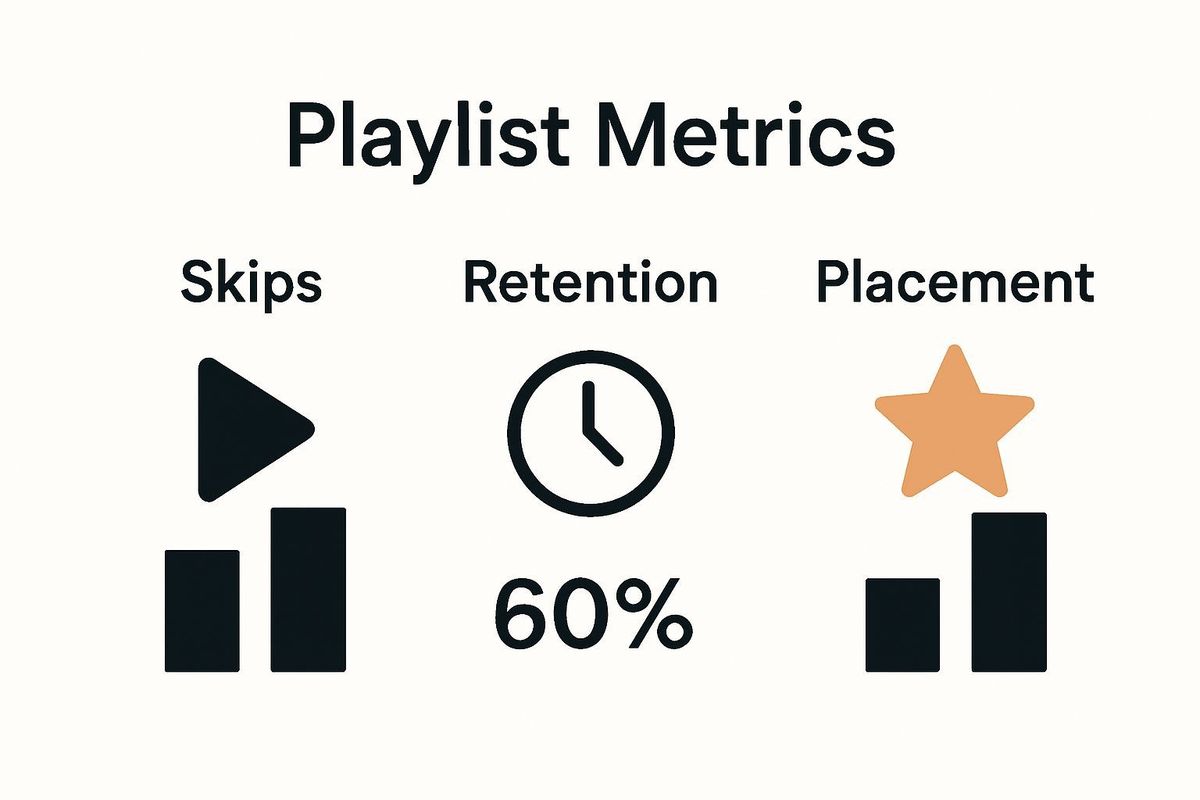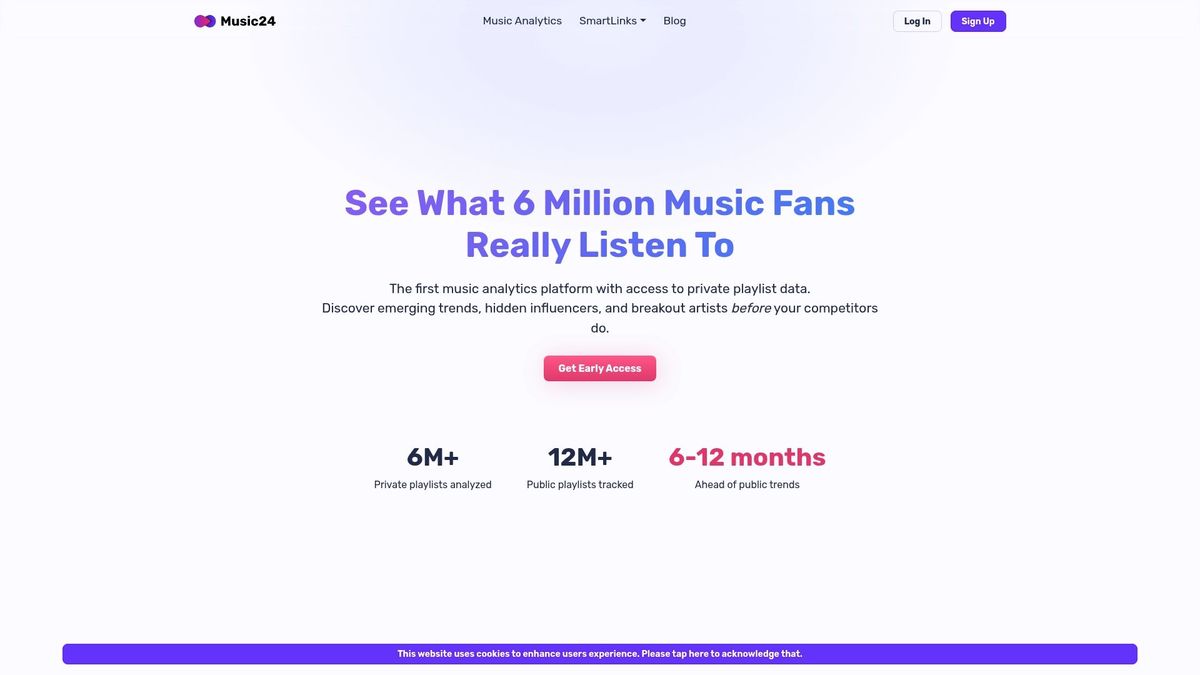Playlist data analysis is changing how people find, enjoy, and talk about music. Over 60% of music discovered by listeners now happens through curated playlists, not radio or charts. Most assume playlists just organize songs, a simple tool for sorting tracks. The twist is these playlists have quietly become the industry’s sharpest tool for predicting the next big thing before anyone else even hears it.
Table of Contents
- What Is Playlist Data Analysis And Its Importance?
- Key Concepts In Playlist Data Analysis
- How Playlist Data Influences Music Trends And Discoverability
- The Role Of Data In Shaping Music Marketing Strategies
- Real-World Applications Of Playlist Data Analysis In The Industry
Quick Summary
| Takeaway | Explanation |
|---|---|
| Playlist data reveals listener trends. | Analyzing playlists provides insights into listener preferences and emerging genres, helping professionals spot trends early. |
| Data drives targeted music marketing. | Using detailed listener data enables personalized marketing campaigns that effectively reach specific audience segments. |
| Identifying potential artists with data. | Continuous tracking of playlist inclusion allows music professionals to discover and support artists before they become mainstream. |
| Understanding emotional context enhances playlists. | Examining the emotional aspects of playlist curation offers deeper insights into what drives listener engagement and preferences. |
| Algorithmic insights empower discoverability. | Data-driven insights into algorithmic recommendations create pathways for artists to gain visibility in crowded markets. |
What is Playlist Data Analysis and Its Importance?
Playlist data analysis represents a sophisticated approach to understanding music consumption patterns by examining how listeners organize, interact with, and curate musical collections across digital platforms. This emerging field transforms raw playlist information into actionable strategic insights for music industry professionals.
Understanding the Core Concept
At its fundamental level, playlist data analysis involves collecting and interpreting comprehensive data from user generated and algorithmic playlists. Researchers have discovered that these digital collections provide unprecedented visibility into listener preferences, genre trends, and emerging artist discovery mechanisms.
Key components of playlist data analysis include:

- Tracking song placement and frequency across multiple playlist ecosystems
- Measuring listener engagement through retention and skip rates
- Identifying cross genre and micro trend development patterns
- Evaluating playlist creator influence and network distribution
Strategic Importance for Music Professionals
Music industry professionals leverage playlist data analysis to make informed decisions about artist development, marketing strategies, and audience targeting. By understanding granular listener behavior, managers and record labels can:
- Predict potential breakthrough artists before traditional metrics emerge
- Design targeted promotional campaigns based on precise audience segments
- Understand evolving listener tastes across different demographic groups
The strategic value lies in moving beyond surface level metrics to comprehend the complex ecosystem of musical consumption. Read more about playlist data strategies to gain deeper insights into this transformative approach.
Playlist data analysis transforms abstract listener interactions into concrete, actionable intelligence that drives music industry innovation and artist success.
The following table organizes the core concepts of playlist data analysis, summarizing their definitions and significance in music industry applications.
| Core Concept | Definition | Significance |
|---|---|---|
| Playlist Data Analysis | The examination of user-generated and algorithmic playlists to interpret music consumption trends. | Reveals listener preferences and spots emerging genres/artists. |
| Computational Music Mapping | Analyzing relationships between track placement, context, and listener engagement in playlists. | Discovers track popularity dynamics and genre/style blending. |
| Listener Behavior Deconstruction | Examining psychological and social motivations behind playlist creation and consumption. | Understands emotional context and demographic influence. |
| Trend Identification | Using metrics like playlist inclusion and retention to detect musical trends early. | Predicts genre shifts and emerging artist movements. |
| Strategic Targeting | Creating audience segments based on detailed playlist data analysis. | Enables highly personalized, effective marketing campaigns. |
Key Concepts in Playlist Data Analysis
Playlist data analysis transcends simple track counting by employing sophisticated methodological approaches that uncover nuanced patterns in music consumption and listener behavior. Understanding these fundamental concepts enables music professionals to extract meaningful insights from complex digital ecosystems.
Computational Music Mapping
Researchers exploring track popularity modeling have developed advanced techniques to understand how songs gain traction within playlist environments. This computational approach involves analyzing intricate relationships between track placement, contextual positioning, and listener engagement.
Key computational mapping strategies include:
- Tracking song transition patterns and listener journey mapping
- Analyzing temporal progression of track popularity
- Identifying genre crossover and musical style blending points
- Measuring algorithmic playlist generation mechanics
Listener Behavior Deconstruction
Understanding listener behavior requires examining multiple dimensions of playlist interaction. Music professionals must look beyond surface metrics to comprehend the underlying psychological and cultural factors driving playlist creation and consumption.
Critical behavioral analysis components involve:
- Emotional context of playlist curation
- Social signaling through musical selection
- Demographic influence on playlist composition
- Contextual listening environments
Read more about types of playlist data to gain deeper insights into these complex interactions.
By integrating computational analysis with nuanced behavioral understanding, playlist data analysis provides a comprehensive framework for interpreting the ever evolving landscape of digital music consumption.
How Playlist Data Influences Music Trends and Discoverability
Playlist data has transformed from a simple music organization tool into a powerful predictive mechanism for understanding emerging musical landscapes and artist potential. This sophisticated ecosystem provides unprecedented insights into listener preferences and genre evolution.
Trend Identification Mechanisms
Digital music research studies reveal that playlist data serves as an early warning system for musical trends, detecting micro genre shifts and emerging artist movements before traditional industry metrics catch up. By analyzing playlist inclusion, skip rates, and listener retention, professionals can identify nascent musical directions with remarkable precision.
Key trend identification strategies include:
- Tracking cross genre playlist integrations
- Monitoring listener retention across different musical styles
- Analyzing playlist creator diversity and influence
- Detecting emerging artist momentum through playlist appearances
Discoverability Dynamics
Playlist data fundamentally reshapes how artists gain visibility in an oversaturated digital music marketplace. Unlike traditional radio or physical media distribution, playlist inclusion provides a direct pathway to targeted listener segments. Artists can now leverage data driven insights to understand precisely how their music resonates across different audience groups.
Critical discoverability factors encompass:
- Algorithmic playlist recommendation mechanisms
- Network effects of playlist sharing and curation
- Listener demographic segmentation
- Geographic listening pattern variations
Discover more about playlist trends that are revolutionizing music industry discovery mechanisms.
Playlist data has evolved from a simple listening tool to a complex ecosystem that democratizes music discovery, providing unprecedented opportunities for emerging artists and innovative music professionals.

The Role of Data in Shaping Music Marketing Strategies
Modern music marketing has transitioned from intuition driven approaches to precision targeted strategies powered by comprehensive playlist data analysis. This revolutionary shift enables music professionals to create highly personalized, data informed marketing campaigns that resonate directly with specific audience segments.
Strategic Targeting and Audience Segmentation
Marketing research in digital music platforms demonstrates that granular data insights allow unprecedented audience understanding. By analyzing playlist behaviors, music marketers can develop nuanced profiles that go beyond traditional demographic classifications, capturing the intricate musical preferences and listening patterns of diverse audience groups.
Key strategic targeting components include:
- Identifying niche listener communities
- Understanding cross genre audience migrations
- Mapping emotional and contextual listening behaviors
- Predicting potential fan engagement trajectories
Predictive Campaign Development
Playlist data transforms marketing from reactive to proactive strategies. Instead of responding to market trends, music professionals can now anticipate audience reactions, design targeted promotional activities, and optimize artist positioning before traditional metrics become apparent.
Critical predictive marketing dimensions involve:
- Early artist momentum detection
- Personalized content recommendation strategies
- Precise geographical market expansion planning
- Real time audience sentiment tracking
Learn more about music analytics workflows to maximize your strategic potential.
By integrating sophisticated data analysis techniques, music marketing evolves from a broad broadcast model to a highly personalized, algorithmically informed ecosystem that connects artists with their most receptive audiences more effectively than ever before.
Real-World Applications of Playlist Data Analysis in the Industry
Playlist data analysis has transformed from a theoretical concept into a practical tool that drives strategic decision making across multiple dimensions of the music industry. By converting listener behaviors into actionable intelligence, professionals can now make more informed choices about artist development, marketing, and audience engagement.
Artist Discovery and Development
Streaming platform research demonstrates that playlist data provides unprecedented insights into emerging talent identification. Record labels and A&R teams now leverage sophisticated algorithmic analysis to detect artists with genuine audience potential, moving beyond traditional scouting methods.
Key artist discovery strategies include:
- Identifying artists with consistent playlist inclusion
- Tracking listener retention and engagement metrics
- Analyzing cross genre audience migration patterns
- Detecting early momentum in niche musical communities
Revenue and Monetization Strategies
Playlist data analysis enables music industry professionals to develop more nuanced revenue models that go beyond traditional streaming royalties. By understanding detailed listener behaviors, companies can create targeted monetization approaches that provide value to both artists and audiences.
Critical monetization dimensions involve:
- Predicting potential merchandise sales opportunities
- Identifying optimal concert and tour markets
- Developing personalized fan engagement programs
- Designing targeted licensing and collaboration strategies
Explore more about playlist data impact to unlock deeper industry insights.
Playlist data analysis represents a transformative approach that converts complex listener interactions into strategic opportunities, fundamentally reshaping how the music industry discovers, develops, and monetizes musical talent.
This table summarizes key applications of playlist data analysis in the music industry, highlighting focus areas and practical outcomes for professionals.
| Application Area | Focus | Real-World Outcomes |
|---|---|---|
| Artist Discovery | Tracking playlist inclusion and retention | Early identification of breakthrough talent |
| Artist Development | Analyzing cross-genre migration patterns | Strategic support for artists in emerging niches |
| Revenue Strategies | Predicting merchandise and concert demand | Enhanced monetization via targeted sales efforts |
| Marketing Strategies | Audience segmentation and campaign targeting | Data-driven, personalized promotional initiatives |
| Fan Engagement | Designing tailored engagement programs | Stronger artist-fan relationships and loyalty |
Unlock the True Power of Playlist Data Analysis With Private Insights
Are you struggling to truly understand how emerging talent and music trends take shape before they hit the public radar? The article revealed how relying on public metrics might leave you a step behind. Playlist data analysis is key, but when your insights are limited to what's visible to everyone else, you risk missing out on early signals, hidden genre blends, and the rise of influential curators inside private listening spaces.

Now you can finally move ahead of the competition. Music24.com harnesses the untapped potential of private playlist data, capturing authentic discovery patterns and hard-to-find micro-trends. Want to identify breakthrough artists before they chart or back up your marketing strategy with deeper, predictive analytics? Stop relying solely on public streaming stats. Explore how our tools uncover rising artists and influential curators or learn more about playlist data's real industry impact. Take the next step toward data-driven success. Contact us now for early access to insights that most music pros never see.
Frequently Asked Questions
What is playlist data analysis in the music industry?
Playlist data analysis is the examination of user-generated and algorithmic playlists to understand music consumption trends and listener behavior. To start utilizing it, collect data from various playlists and analyze how genres and artists are performing across these platforms.
How can I use playlist data to identify emerging artists?
You can identify emerging artists by tracking their inclusion in popular playlists and monitoring listener retention metrics. Begin analyzing playlist data monthly to spot potential breakthrough artists before they hit mainstream recognition.
What factors should I consider to enhance my playlist marketing strategies?
Key factors include demographic segmentation, emotional context of playlist creation, and understanding listener engagement patterns. Focus on developing personalized campaigns that cater directly to identified audience groups based on these insights.
How does playlist data help with audience segmentation?
Playlist data allows you to create nuanced profiles of different listener groups by analyzing their playlist behaviors and preferences. Take action by segmenting your audience based on distinct musical tastes and designing targeted engagement strategies to reach them effectively.
What methods can I employ to track listener engagement in playlists?
You can track listener engagement by measuring retention rates, skip rates, and the frequency of song placements across playlists. Set up a regular review process every 30 days to assess these metrics and adjust your artist promotional strategies accordingly.
How can I leverage playlist data for revenue generation?
Utilize playlist data to identify trends that can inform merchandise sales, concert planning, and fan engagement programs. Create targeted strategies within a 60-day timeline to capitalize on insights gained from your analysis, maximizing potential revenue streams.


